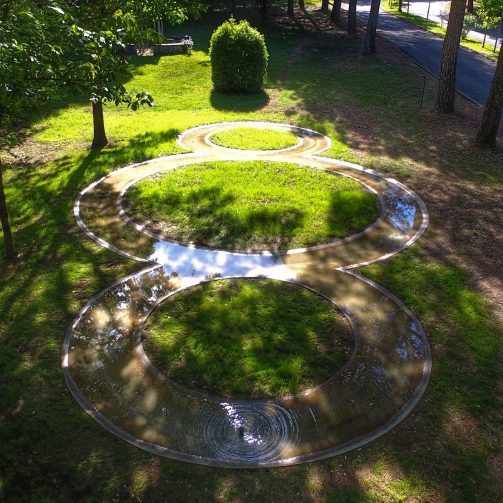Anish Kapoor Earth Cinema:
It is a cut dug into the earth (45 m long), into which people can enter from both sides. Inside, a long slit allows people to “see” the landscape, feeling part of it. It is a bottleneck in the bottom just 7 m wide, where Kapoor invites people to find a sound, an echo of Mother Earth, to find an image on the screen placed in the center of the side of the slit in which no moving figures appear, but reflections, shadows of the vegetation above. The work opens a new artistic viewpoint on the land, inviting the viewer to observe it from within. “It is a work that has an architectural scale and requires a kind of physical response, it is not made to be just looked at but is an experience that you live… The idea is that of the inside of the earth, of a cave… somehow you know that it is not a natural cave but a kind of man-made cavity… there is a dialogue between culture and nature.”
Michelangelo Pistoletto
It is the fusion of the first and second paradises. The first is the one in which human beings were totally integrated into nature. The second is the artificial paradise, developed by human intelligence to the global dimensions reached today with science and technology. This paradise is made up of artificial needs, artificial products, artificial comforts, artificial pleasures and every other kind of artifice. A veritable artificial world has been formed which, with exponential progression, ingenerates, parallel to the beneficial effects, irreversible processes of degradation and consumption of the natural world. The Third Paradigm is the third stage of humanity, which is realized in the balanced connection between artifice and nature.
Third Paradigm means the transition to an unprecedented stage of planetary civilization, which is indispensable to ensure humankind’s survival. To this end, it is first necessary to re-form the ethical principles and behaviors that guide
common life. The Third Paradise is the great myth that leads everyone to take personal responsibility in the global vision. The term paradise comes from the ancient Persian language and means “protected garden.” We are the gardeners who must protect this planet and care for the human society that inhabits it.
The symbol of the Third Paradise, a reconfiguration of the mathematical sign of infinity, consists of three consecutive circles. The two outer circles represent all diversity and antinomies, including nature and artifice. The middle one is the interpenetration between the opposite circles and represents the generative womb of the new humanity.
Michelangelo Pistoletto, 2003
Alessandro Armento
A sound exchange that passes through the ground and joins with other sounds creating symbiosis of meaning, in a profound invitation to listen to the earth and oneself: this is the concept of the art project ‘Lichene’ by Alessandro Armento, a young artist from the Academy of Naples.
The work was created as part of the ArtePollino Prize. The ArtePollino Prize consists of a competition aimed at students of the Italian Academies of Fine Arts that includes a summer school in the territory of the Pollino National Park and, in the following period, the development of an art project inspired by the art and landscape of the Park.









